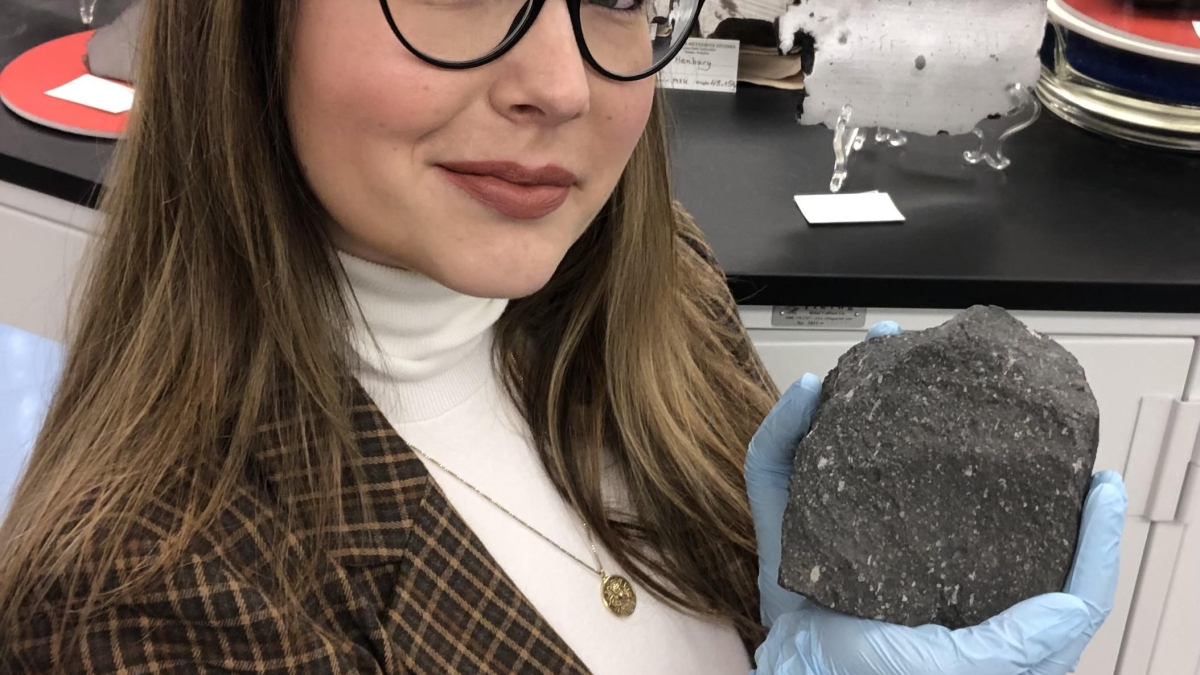NASA selects ASU researcher for Martian Moons eXploration Participating Scientist Program

Jemma Davidson holding a carbonaceous chondrite.
NASA has announced the selection of U.S. participating scientists in the Japan Aerospace Exploration Agency (JAXA)-led Martian Moons eXploration (MMX) Mission to return samples from the Martian moon Phobos. Arizona State University researcher Jemma Davidson will join the MMX Mission's Sample Analysis and Science Working Teams as a participating scientist.
Davidson, an isotope cosmochemist and petrologist, studies meteorites from asteroids and Mars from the extensive Carleton B. Moore Meteorite Collection in the Buseck Center for Meteorite Studies (BCMS) in the School of Earth and Space Exploration.
The purpose of the MMX Mission is to constrain the origins of Mars' moons Phobos and Deimos. They have been speculated to have formed from a giant impact that ejected pieces of Mars, or they are possibly carbonaceous asteroids that were captured by Mars' gravity. The JAXA-led MMX Mission will study these moons and return a sample from Phobos to Earth in 2029. Davidson, a research scientist at BCMS, will lead a team to investigate samples, including co-investigators Devin Schrader, also from BCMS, Arya Udry from the University of Nevada, Las Vegas, and collaborator Noriko Kita from the University of Wisconsin-Madison.
“Davidsons’ work exemplifies the mission of BCMS to use the planetary materials in the Moore meteorite collection and returned samples to uncover the processes that shaped the Solar System over its 4.6 billion-year history,” said Rhonda Stroud, director of Buseck Center for Meteorite Studies.
“As one of the scientists from the U.S. selected by NASA to participate in this mission, Dr. Jemma Davidson will play a leading role in the analysis of the returned samples,” said Meenakshi Wadhwa, director of the School of Earth and Space Exploration. “Her selection is a well-deserved recognition of her expertise and also highlights ASU’s support and commitment to sample science.”
Davidson will use microscopy and mass spectrometry methods to analyze opaque minerals in samples returned from Phobos to investigate this moon's origin and evolution. Opaque minerals (so named because they do not transmit light in thin sections) such as spinel, magnetite and sulfide are specific to how and where they formed. As a result, opaque minerals in asteroids are chemically and isotopically different from those on Mars. By studying these minerals, Davidson will be able to determine the nature and formation history of Phobos.
"By comparing the compositions of Phobos' opaque minerals with those in a wide variety of extraterrestrial samples, such as the meteorites in the Carleton B. Moore collection, we will be able to determine whether Phobos is a captured asteroid or if it formed from a giant impact on Mars," said Davidson.
Davidson will investigate the mineralogies as well as the chemical and oxygen isotope compositions of opaque minerals in samples returned from Phobos to reveal important information about the formation and alteration conditions of this Martian moon. She will use state-of-the-art coordinated microanalytical techniques, including field emission electron microscopy at Arizona State University and secondary ion mass spectrometry at the University of Wisconsin-Madison.
"Opaque minerals are sensitive indicators of both the conditions under which they formed and were then altered," said Davidson. "Not only will we learn about how and where Phobos formed, we will also learn how it evolved."
More Science and technology

ASU researcher part of team discovering ways to fight drug-resistant bacteria
A new study published in the Science Advances journal featuring Arizona State University researchers has found…

ASU student researchers get early, hands-on experience in engineering research
Using computer science to aid endangered species reintroduction, enhance software engineering education and improve semiconductor…

ASU professor honored with prestigious award for being a cybersecurity trailblazer
At first, he thought it was a drill.On Sept. 11, 2001, Gail-Joon Ahn sat in a conference room in Fort Meade, Maryland.…